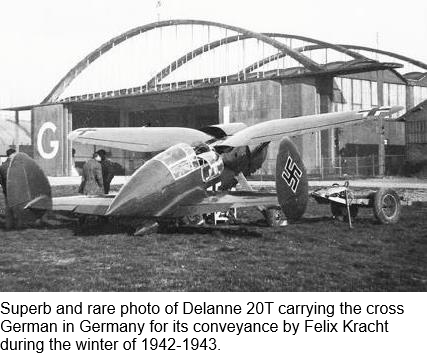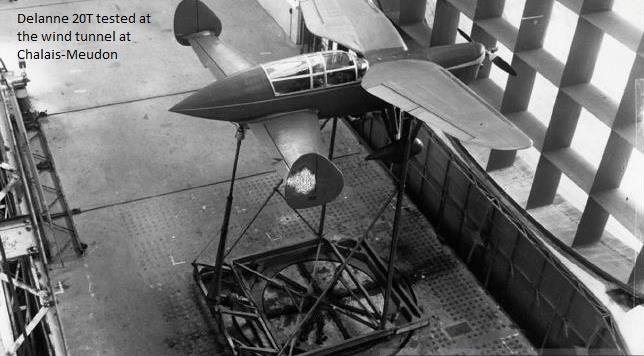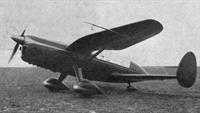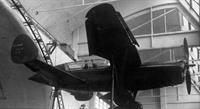Though sometimes described as a tourer and at others, incorrectly, as a fighter aircraft, the chief purpose of the Delanne 20-T was to explore the characteristics of the tandem wing Arsenal-Delanne 10, which was a fighter, larger than the 20-T and more powerful but aerodynamically very similar; the 20-T, the design of which was underway in the spring of 1937, is best described as a macquette or aerodynamic model of the Arsenal-Delanne 10.
Its two, tandem, wings were very different in plan and well separated vertically, the forward one the higher, with about 840 mm between them over most of the span. Their minimum separation horizontally was about 650 mm
In plan the leading edge of the forward wing was straight, with only slight sweep out to rounded tips; the trailing edge was also straight but strongly forward swept, producing strong taper over the outer 70% of the span. Inboard the wing chord reduced linearly by about 30% to the root. The outer wing had 3° of dihedral, though the narrowing centre section curved downwards strongly to the roots. The Delanne 20 was an all wood aircraft and each wing was built around two spruce and plywood box spars. The trailing edges carried ailerons and camber changing flaps, coupled to slats on the corresponding sections of the leading edges. The wings were attached to the fuselage upper longerons at their roots and braced to the lower fuselage by a V-form pair of struts from the lower fuselage at about 35% span.
The rear wing was a one piece structure, trapezoidal in plan with an unswept leading edge and constructed like the forward wings. It also had ailerons and flaps, though there were no slats. It was a cantilever structure, attached to the lower fuselage in a way that allowed its angle of attack to be adjusted on the ground. At its tips were fins and unbalanced rudders of combined oval shape.
The fuselage was built around four spruce longerons and was plywood covered. The Delanne 20-T was powered by a 130 kW (180 hp) Régnier 6 B-01 six cylinder air-cooled inverted inline engine, driving a two blade propeller. The tandem wing design allowed the centre of gravity to be further aft than usual, so the cockpit canopy stretched from the forward wing trailing edge to above the rear wing; the profile of the rear fuselage followed that of the canopy to a pointed rear. Under the canopy the two seats were in tandem and had dual controls; in emergency, the canopy could be jettisoned.
The Delanne 20-T had tailwheel, fixed landing gear, each of its mainwheels independent mounted on a pair of converging tubular legs to the lower fuselage. The rear member was an oleo strut shock absorber and the pair was enclosed in a fairing, as was the wheel. There was also a light strut from the bottom of the pair to the central fuselage underside. The tailwheel was likewise faired.
| Type |
Two seat experimental |
| Engine |
1 Regnier 6 B-01 with a 2-blade Ratier 1380 propeller variable pitch, dia. 2,10 m |
| Dimensions |
Length 6,78 m, height 2,40 m, span 7,86 m , rear wing 5,66 m, total wing area 14 m2 (Both wings) |
| Weights |
Empty 730 kg, loaded 1031 kg , max. take off weight |
| Performance |
Max.. speed 262 km/h , cruising speed , range , endurance , service ceiling , climb, stall speed 70 km/h |
| Type |
Werk.Nr |
Registration |
History |
|
|
|
The first prototype was destroyed in an accident during his second flight August 10, 1938, killing the pilot Guy Chateaubrun. The second prototype flew for the first time April 15, 1939 at the hands of Ferdinand Lasnes. This was tested by CEMA to Villacoublay, then at Bricy. Discovered
by the Germans, who were intrigued by its aerodynamic formula, this aircraft was evaluated in the Chalais-Meudon wind tunnel It was then transferred to Germany during the winter of 1942-1943, before being joined by its big brother, the Delanne 10. Felix Kracht, manager of DFS, took the Delanne 20T to the testing ground at Airing , later to the gliding field Prien. After some trials, the formula was considered disappointing, especially the
very poor forward visibility. |




